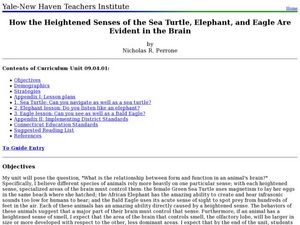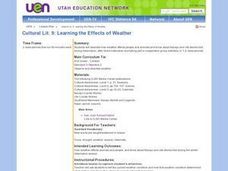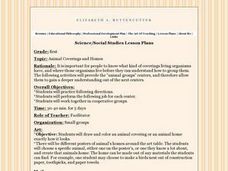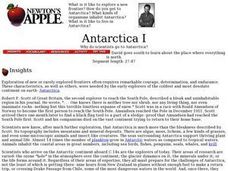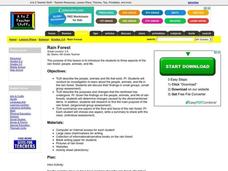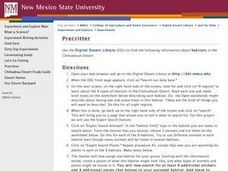Curated OER
Forest Habitats
In this identification lesson, 3rd graders view photographs of different kinds of forests, learn where forests are located, and discuss seasonal changes in forests. Students read Look What I Did With a Leaf, collect leaves, identify what...
Curated OER
Different Environments
Pupils read literature selection, discuss habitat, divide habitats into different categories such as water, soil, and land, list animals that live in each habitat, and describe habitats using descriptive words in vocabulary list.
Curated OER
How the Heightened Senses of the Sea Turtle, Elephant, and Eagle Are Evident in the Brain
Students explore the senses of different animals. For this biology lesson plan students will study the animals selected for their grades. The students will learn about the brain and how the senses of that animal have developed.
Curated OER
Learning the Effects of Weather
Second graders examine how weather affects animals and people. They discuss Navajo and Ute stories told during different seasons of the year, and create a drawing of people or animal behavior and the connection to the weather.
Curated OER
Animal Coverings and Homes
First graders research what kind of coverings living organisms have, and where those organisms live before they can understand how to group them. The following activities will precede the "animal groups" centers, and therefore allow them...
Curated OER
Become a Collector
In this collection worksheet, students read a 1-page selection regarding collections and then respond to a question regarding collections and draw a picture of a collection.
Curated OER
Explore the Arctic: A Scavenger Hunt
Learners explore the Arctic region using the internet. They identify characteristics of animals that live in the Arctic and locate the Arctic region using a map of the United States.
Curated OER
Water Pollution, Stream Ecosystems
Students participate in a series of simulated activities designed to demonstrate the interconnectedness between the environment and the organisms that live there. They explore how polluting one element of an environment affects the...
Curated OER
Verterbrate Classification
Students are introduced to the broad categories of vertebrates including fish, amphibians, reptiles, birds and mammals. They identify the characteristics of each group and then view slideshows and video of example species.
Curated OER
Antarctica I
Students explore exploring and expiditions then simlate their own on campus. They divide into small "expedition groups." Have each team report back to the class about their expeditions, using written, oral, or videotaped presentations.
Curated OER
Classification 2: A Touch of Class
Young scholars examine how many kinds of living things (e.g. plants and animals) can be sorted into groups in many ways using various features to decide which things belong to which group and that classification schemes vary with purpose.
Curated OER
The Edge of Home
Students explain why some species of plants and animals occur in more than one area. They watch as the teacher puts an overlapping circles on the chalkboard, students are asked to predict what kinds of things they would expect to find in...
Curated OER
Plant and Animal Communities
Second graders discuss the six main classes of animals: insects, birds, fish, mammals, amphibians, and reptiles. They complete a variety of activities about animals. They solve animal riddles, categorize toy animals, create an animal...
Curated OER
Animal Camouflage
Students investigate how animals adapt to their environment. In this animal science instructional activity, students participate in an experiment using patterned paper and plain paper to simulate how animals blend into their...
Curated OER
Animal Coverings
Summary: Categorize animal pictures by their coverings. Show photographs of animals. Ask students to give descriptive words as to how they think the animal's covering would feel if they could actually touch it.
Curated OER
Rain Forest
Students discover three aspects of the rain forest. They describe the people, animals, and vegetation in the rain forest. They identify the changes the rain forest has gone through and the reasons behind the changes. They choose one...
Curated OER
Habitat
Learners are able to define habitat. They are able to identify the four things that living things need to survive. Students are able to describe how living things are adapted to their habitats.
Curated OER
Rainforest Adventures
Learners study the vegetation and types of animals that live in the rainforest. They role-play their favorite rainforest animals and write letters from the viewpoint of their favorite animals. After writing their letters, they view a...
Curated OER
Research: Habitats in the Chihuahuan Desert
In this desert habitat worksheet, learners follow the links to research information about the Chihuahua desert. Students fill out the graphic organizer with facts about the habitat, animals and plants of this region.
Curated OER
Bears, Bears, and More Bears!
Students learn the different kinds of bears, discover how bears move, andlearn what bears eat. They also explore bear habitats and list the differences between real bears and imaginary or fantasy bears
Curated OER
All About Birds
Students study different kinds of birds, and demonstrate reading comprehension skills, including reading strategies, inference, literal meaning, and critical analysis.
Curated OER
Texture: Wild Things
Students experiment with different kinds of marking techniques. They read "Where the Wild Things Are" and observe animals for pattern and line. They compare illustrations with Haring's images. They create a symbolic drawing of animal.
Curated OER
Chips Ahoy: Chip Off the Old Block
First graders compare and contrast adult and baby animals to identify similar characteristics shared by both.
Curated OER
Footprint Detectives: Making Inferences Using Dinosaur Trackways
Students analyze and discuss footprints and dinosaur tracks. They listen to books about paleontologists, create and analyze their own trackways using black paper and chalk, examine the data, and form hypotheses about footprints and...




